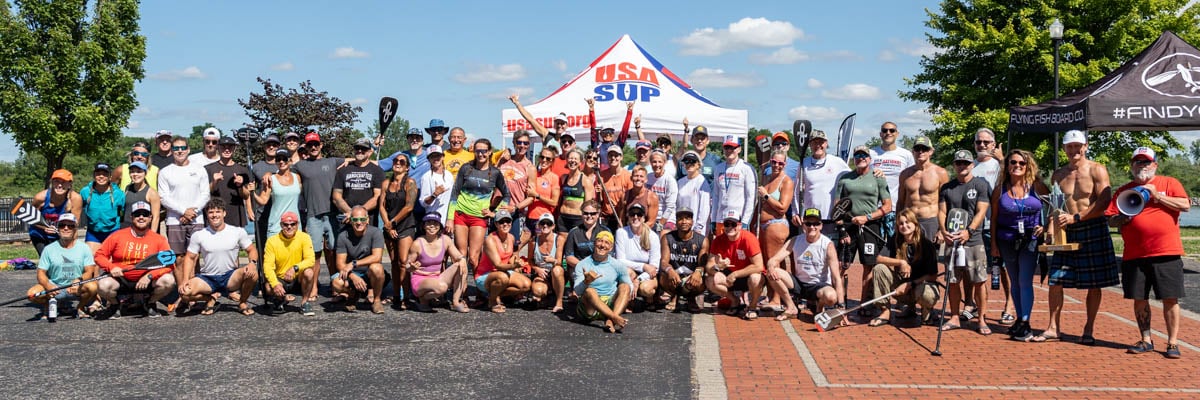
Congratulations to all of the organizers, volunteers, and competitors who made this year’s USA SUP National Championships possible!
I traveled to Detroit, MI to take part in the 2025 USA SUP National Championship races this July – and it was incredible!
I signed up for the USA SUP National Championships early this year (just a few days after registration opened) and wrote out a training plan for myself to get ready. Of course life has a fun way of messing up the best laid plans, so that four month training plan unwound pretty hard and ended up being more like a half dozen sporadic training sessions. But that’s OK – my favorite part of SUP racing is being there, meeting all the wonderful people in the sport, and having a good time. My typical goal in any race I enter is “not last.” and knowing that I’d be up against some of the best paddlers in the country I decided to take one more step back and change my goal to “participate, give it everything I’ve got, and have fun no matter where I end up.”
Well, I’m glad to say that I crushed that goal!
What was even more exciting is that I did it my way. I chose to use, and for two days of competition was the only paddler to use, an inflatable racing SUP. Could I have rented a hard board? Sure. Flying Fish drove a dozen plus boards all the way from Florida for paddlers who couldn’t travel with their board. Would I feel comfortable racing on equipment I’ve never used before? Absolutely not. Especially when warm up time is at an extreme premium (or non-existent), and you are fighting wind, current, wake, and wash while trying to put down every ounce of effort you have. I’ve done it before, and the results weren’t better (and were likely worse by the way that race went) than if I had used an inflatable race board.
Could I have gone faster and potentially placed higher using a hard board instead of an inflatable? Honestly, I don’t think so. Maybe in the sprint race, but I don’t think it would have changed anything in the technical or distance races. I’ve tested the Hydrus Elysium Air against my NSP Ninja carbon fiber race board and it’s pretty obvious that I’m the key element holding either of these boards back from their potential!
So let’s see how it all went down!
Friday July 18 – Sprint Races
The first day of the USA SUP Nationals kicked off with 100m sprint races on the Detroit River at the Wyandotte Boat Club.
This would be my first ever sprint race – a type of racing that’s not really held much interest for me, and that I’ve only ever even practiced once (about two weeks prior).
The course was simple at first glance. Start between a pair of buoys, sprint 100m upriver, and finish between another set of buoys at the end of the dock.

The 100m sprint course at the Wyandotte Boat Club seems straight forward at first.
The sprint races were held in a series of heats. Each age division (Grand Masters – 60+, Masters – 50-59, Open – 18-49, Junior < 18 years old) and gender division raced in a series of heats with between 4-6 paddlers depending on the number of entrants.
In your heat you are assigned a starting position / jersey color which indicates where you line up on the start line. This proved to have a big impact on results as the course wasn’t as simple as it seems.
If you regularly paddle on rivers you might already see what’s happening. On this stretch of river, the current was much stronger toward the center of the river (the “outside” sprint lane) and much weaker toward the edge of the river (the “inside” lane).
In my first heat I was on the outside lane paddling against the strongest section of the current. However, there were only 4 paddlers in my heat. The top 4 finishers of each heat in the first round moved up to the semi-finals, so I knew I had a place in the next heat and saved some of my energy.
As luck would have it, in the semi-final draw, I was placed on the inside lane in my heat.
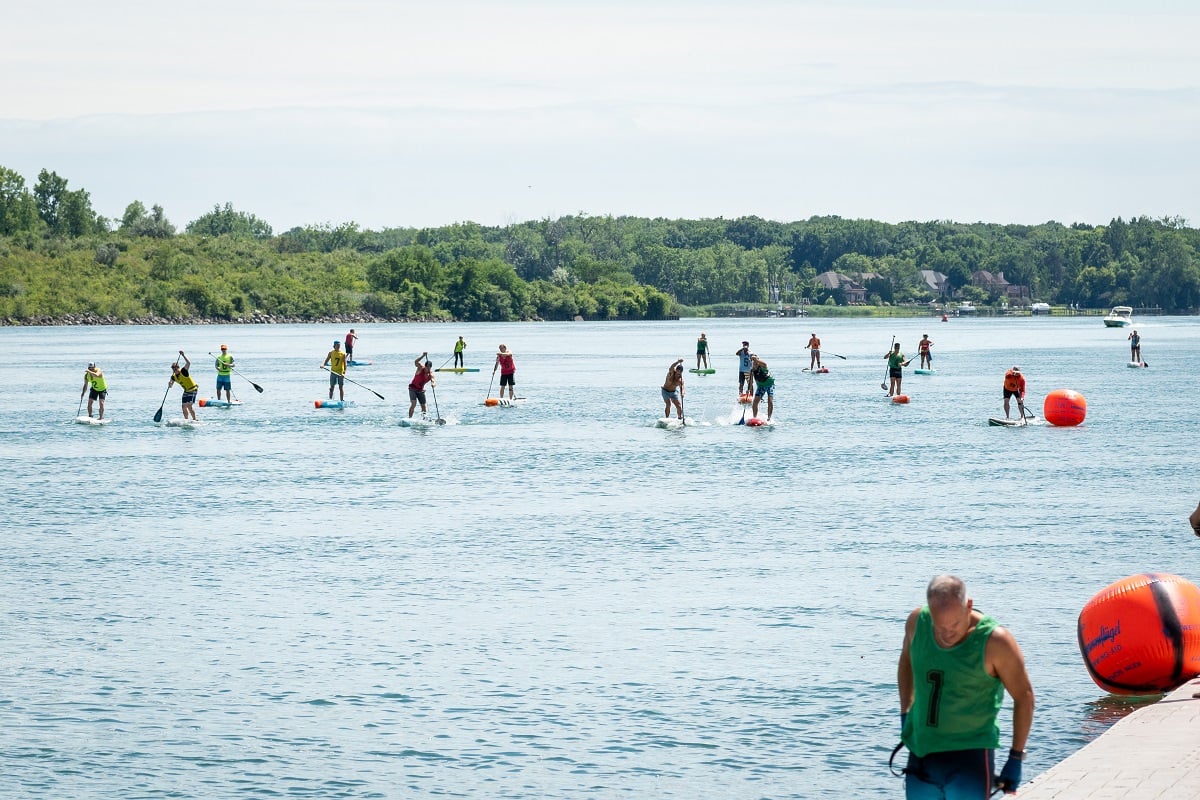
The start of my semi-final sprint heat – I’m on the far right side next to the buoy. The next heats lined up behind to keep the event running smoothly.
On the horn we took off. I knew I needed to keep to the inside as much as possible, but as a goofy-footed paddler with a natural inclination to paddle on my left, I had to force myself to change sides early to stop myself from drifting out. I was a bit worried that changing sides that early could have a big reduction in speed, but it was a smooth transition, and I kept up my pace with almost no break.
There isn’t much to do in a sprint except paddle as hard as you can and remember to breathe every once in a while, but I could see that I wasn’t far behind Evan Young from West Virginia – a super nice dude and excellent paddler.
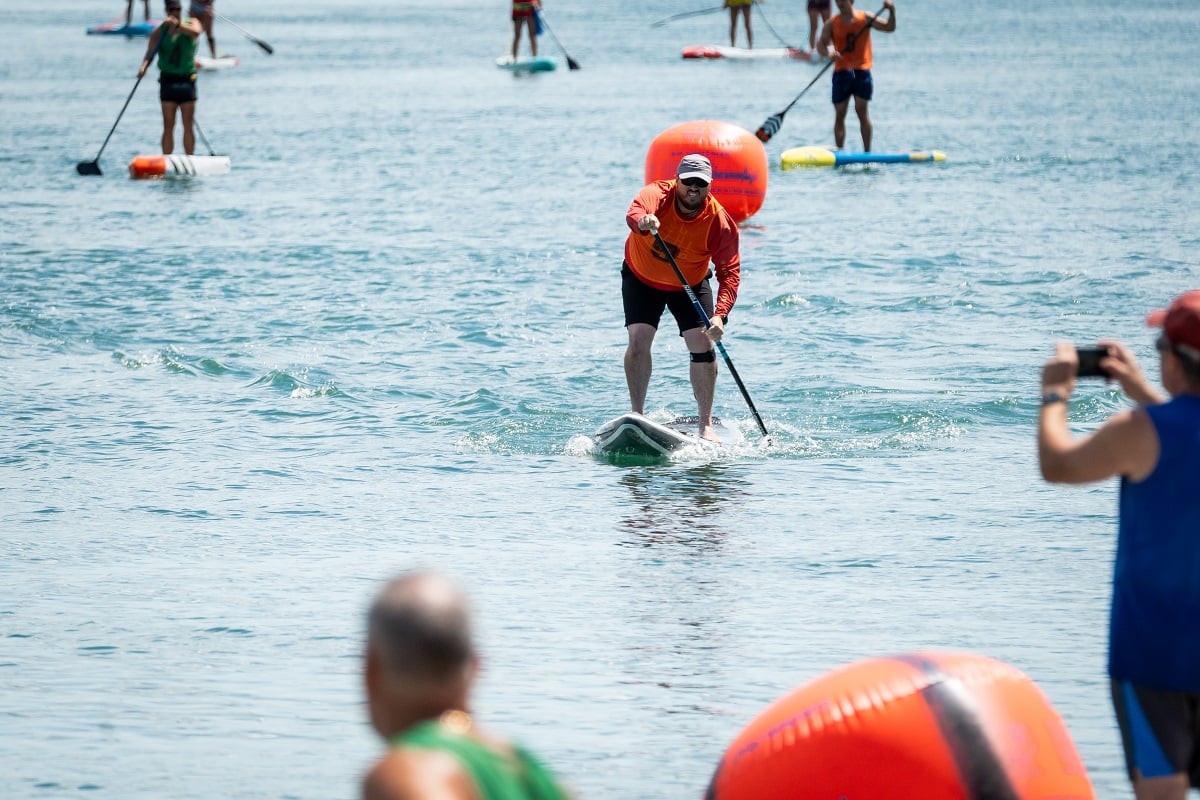
Gritting through while trying to keep up a continuous 80+ strokes per minute!
Jake Portwood and Blake Carmichael both took off like rockets (and would ultimately be #1 and #2 on the podium for the sprint races). About halfway through the heat I saw just how close I was to Evan and I kept pushing hard. The video that USA SUP President Linda McCoy took from the dock shows a great perspective of the finish line with my nose right on Evan’s tail.

Screen capture from the facebook video of the end of my semi-final sprint heat – right on the tail of Evan Young and two board lengths ahead of Troy Hendricks.
I finished 5th out of 6 in the semi-final heat. Not good enough to move up to the finals, but enough to put me (tied) in 9th/17 for the Men’s Open (18-49) sprint races. You can see a video of the entire heat on Facebook thanks to Linda and USA SUP for their livestreaming.
After the semi-final heat there were a lot of paddlers talking to me about my board. They didn’t think inflatables could come anywhere near a hard board (well, we’ve disproven that a few times now). I’ll also freely point out that the Elysium Air is 26” wide – most of the paddlers in the race were on 22-23” wide boards – and that makes a huge difference in maximum speed.
I’ve said it before and I’ll say it again – these aren’t the same inflatables as they were even three years ago!
The rest of the day was an absolute blast. As the unofficial official photographer for the event I got to see everything up close, and watching the amount of power and technique from paddlers like Seychelle and Jake is really inspiring.
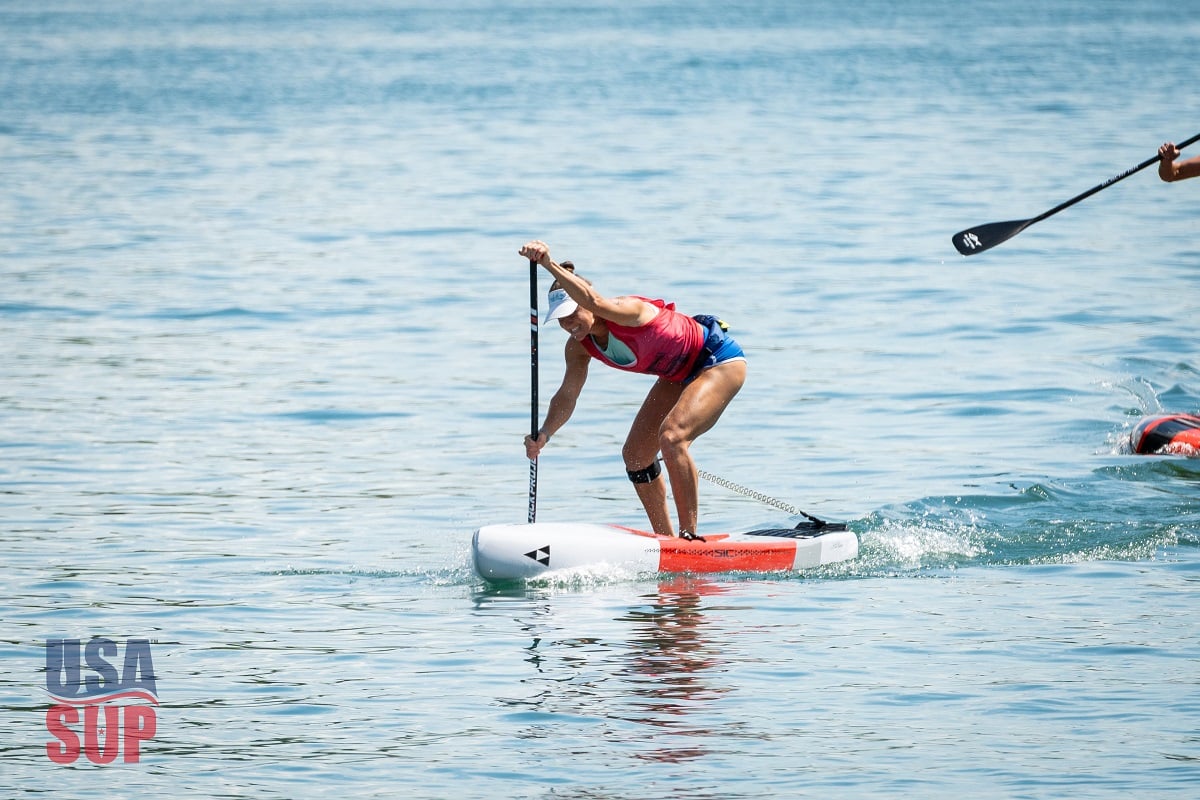
Seychelle powering through the Women’s Open finals in the outer lane
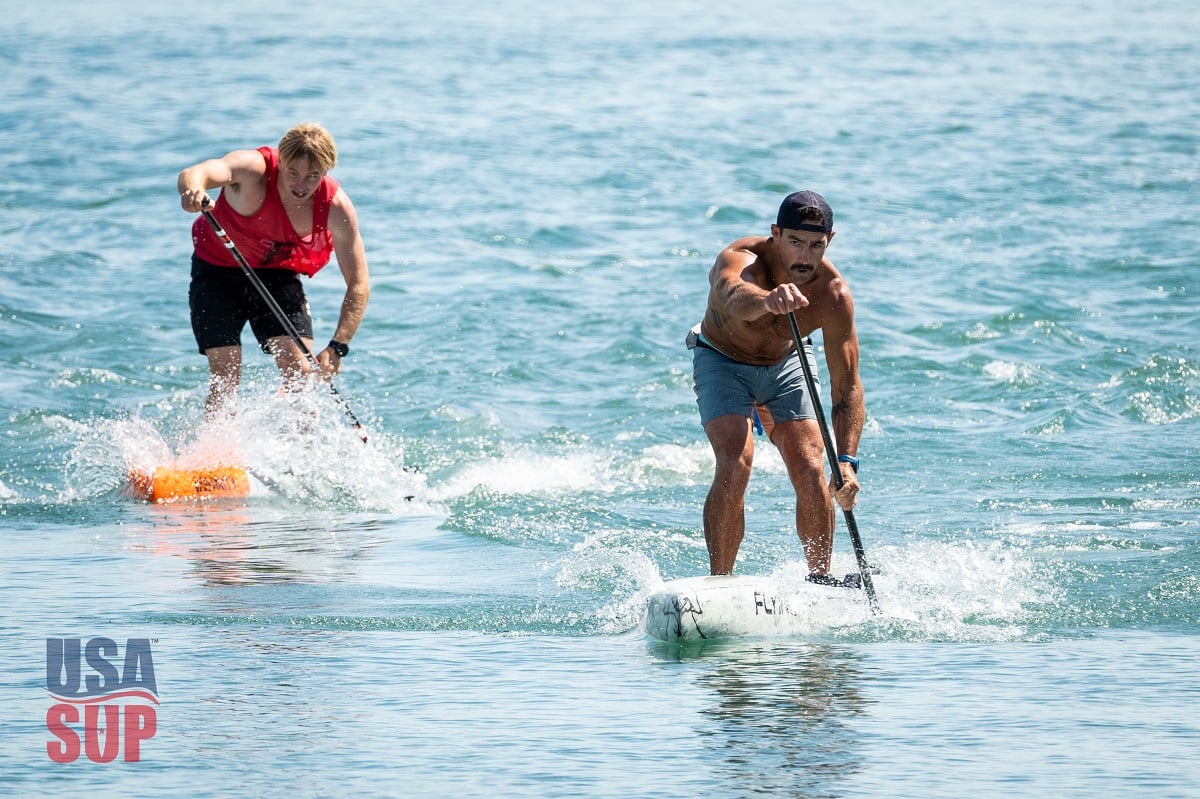
Jake Portwood putting in some horsepower in the final meters of the Men’s Open sprints
Saturday July 19 – Technical Racing
Technical racing is my favorite! It’s fun, it’s fast, and it’s great for spectators. In fact, I think it’s the best format of SUP racing, period. It can be done on short, intense courses like this one, or longer courses like the Rocky Mountain Paddleboard race series on basically any body of water. Shorter courses also make it easy for spectators to see speed, technique, and occasional carnage (a crowd favorite) up close.
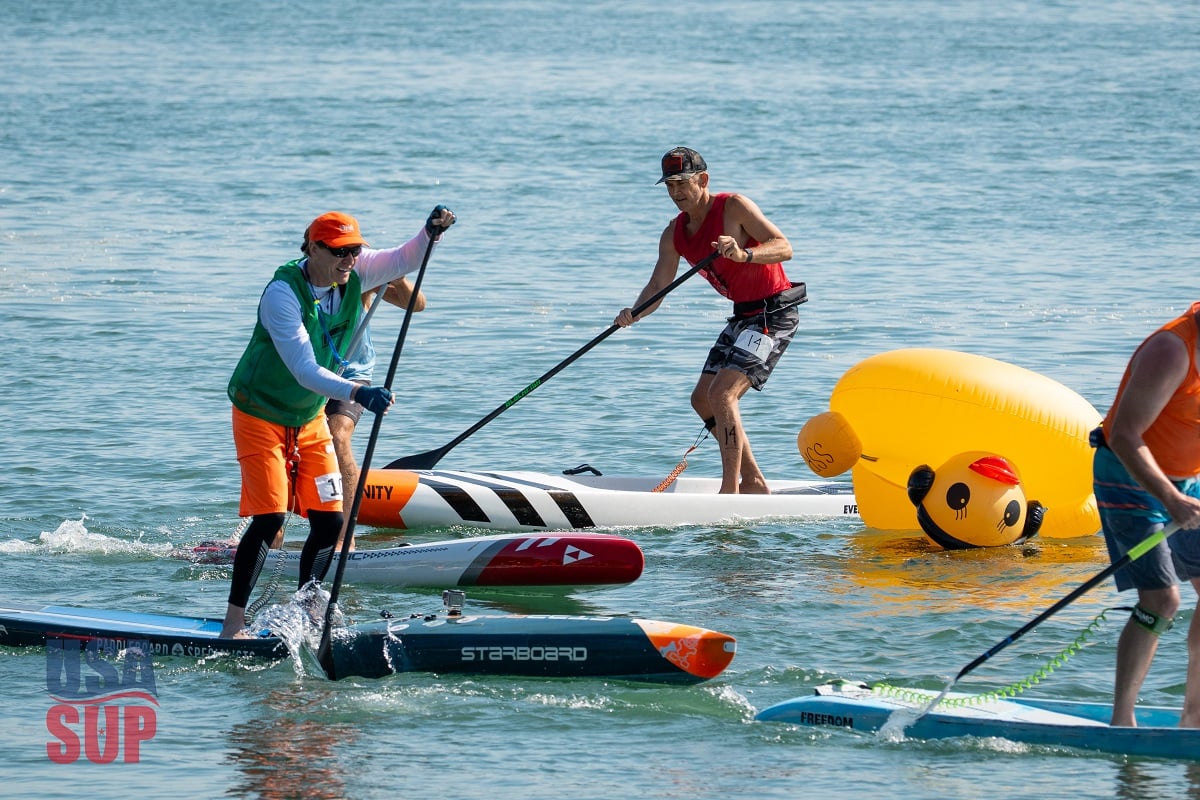
Head-to-head racing with tight turns is exciting for both racers and spectators.
Most of the technical racing I’ve done in the past has been on longer courses – 2-4 miles with 10-20 turns spread out through that distance. The USA SUP technical course involved 8 turns in less than half a mile.
The actual course was a little different than the published race map, but essentially involved the same number and direction of turns. Start at the end of the dock, sprint to a buoy almost 200 meters away, make a 180° turn and come back for a zig-zagging course around 6 more buoys before making a final 180° turn to sprint for the finish line (the close end of the dock).
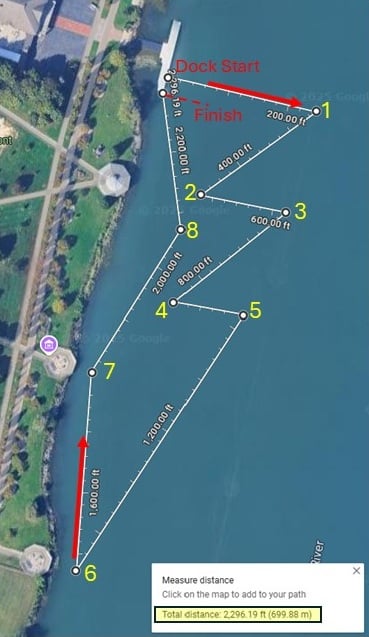
The whole course was almost flipped upside down in orientation, but had essentially the same shape..
The day of the Tech Race started early, and practice time was extremely limited as we were not allowed to be on the water anywhere near the course while other heats were going on. I was able to get two practice laps before the races started, then had a 3 hour break before my heat. That’s a rough schedule.
While the weather had been great on Friday for the sprint races, it wasn’t holding out as well on Saturday. As the day progressed the wind picked up out of the East and really started chopping things up. Most paddlers opted for the safer but slower option cross-bow turns passing buoys on their weak side, rather than attempting a faster, but much riskier pivot turn. We also had the current to contend with so buoys that were parallel to each other actually required paddling up-river against the current to make it around the correct way.
Between the current and wind we also had several buoys drift out of position throughout the day changing the course over time. The race coordinators were re-setting them, but only between divisions, not individual heats. This became a big issue when, during the first heat of the Women’s Open semi-finals the fifth buoy drifted about 50 meters downriver and forced the racers to paddle back up river before making their turn – all without knowing this would be the case when they took off from the finish line. The spectators helped yell directions, though, and everyone was able to make the change.
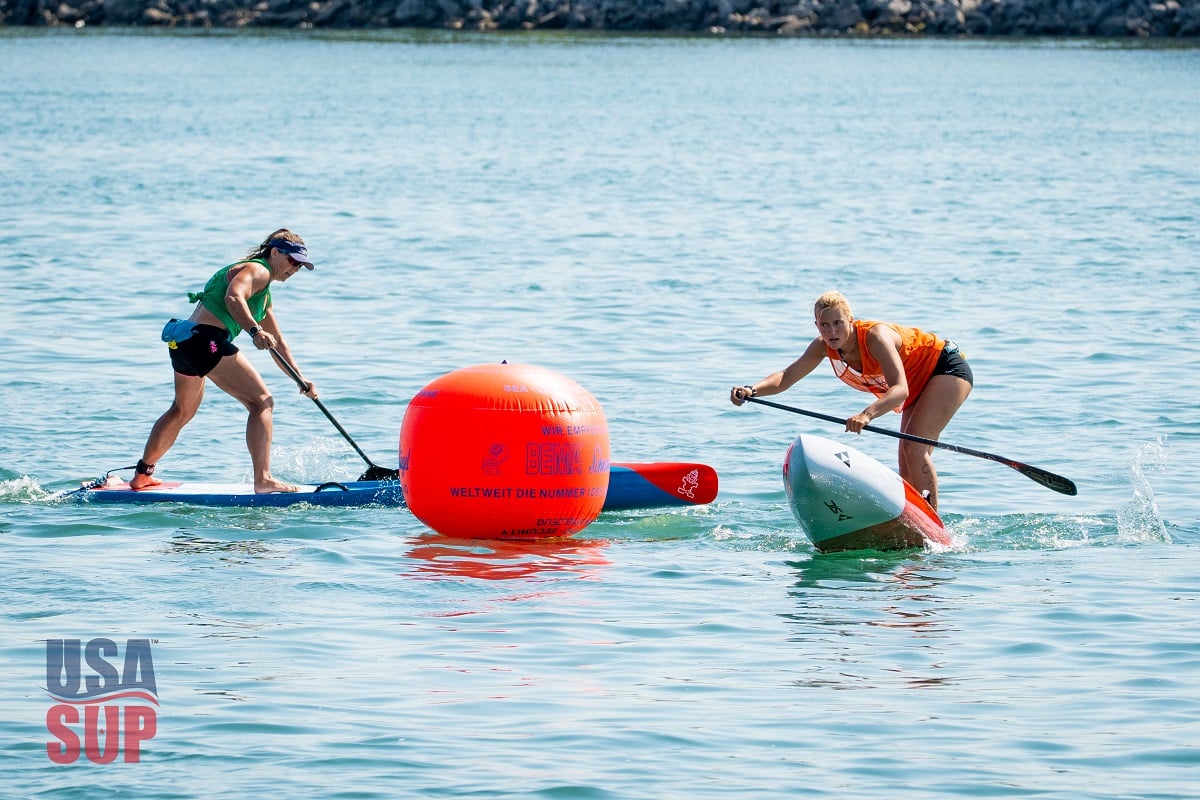
There’s nothing like coming around a buoy only to realize the next turn is not where you expected it to be!
By the time my heat came up the course had shifted a little and the water was getting choppy. I took a slightly off-line route at the beginning to try and stay in the slower current, but went too far and ended up farther back in the pack than I intended. I’m a goofy-footed paddler, so I’m better with my right-shoulder turns and limited my pivot turns to my strong side (which thankfully had more turns than my weak side) and in each straightaway I was able to catch up to the other paddlers in my group. But my weak side turns (most people’s strong side) were slow enough that I’d lose part of that gain each time.
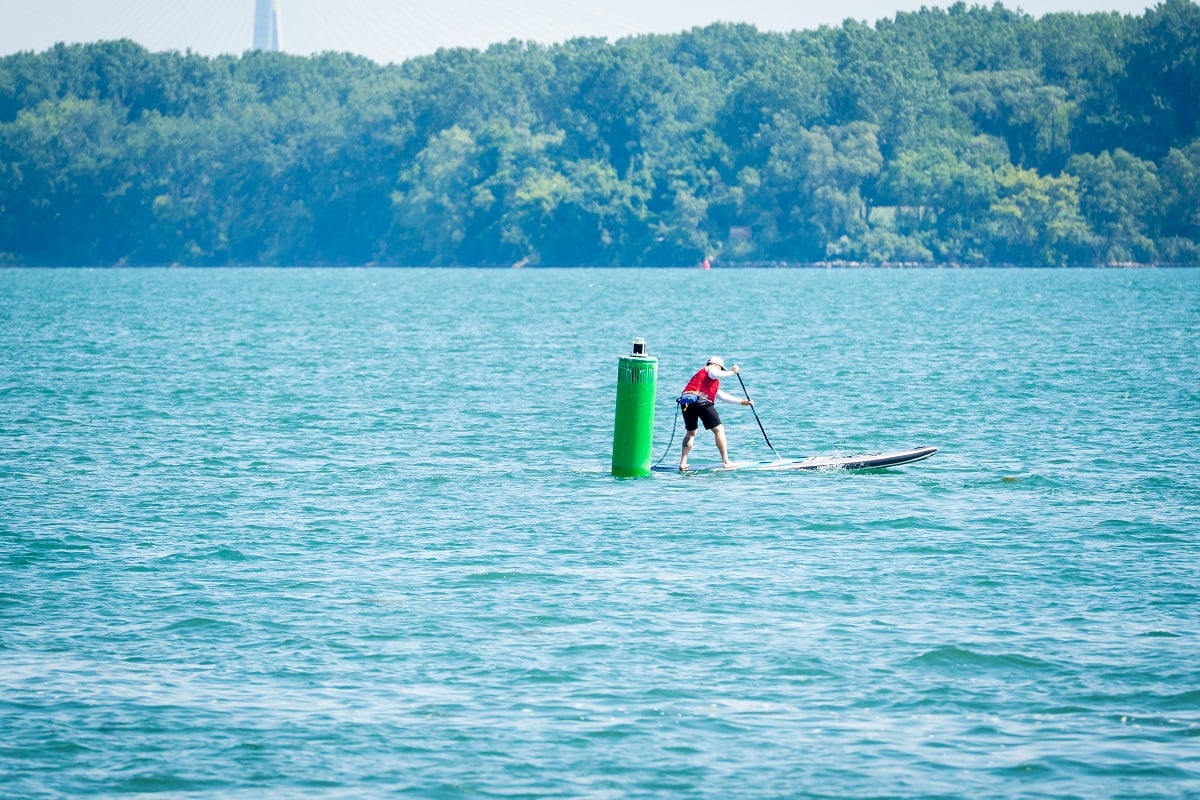
Pivot turning around the first buoy on my strong side
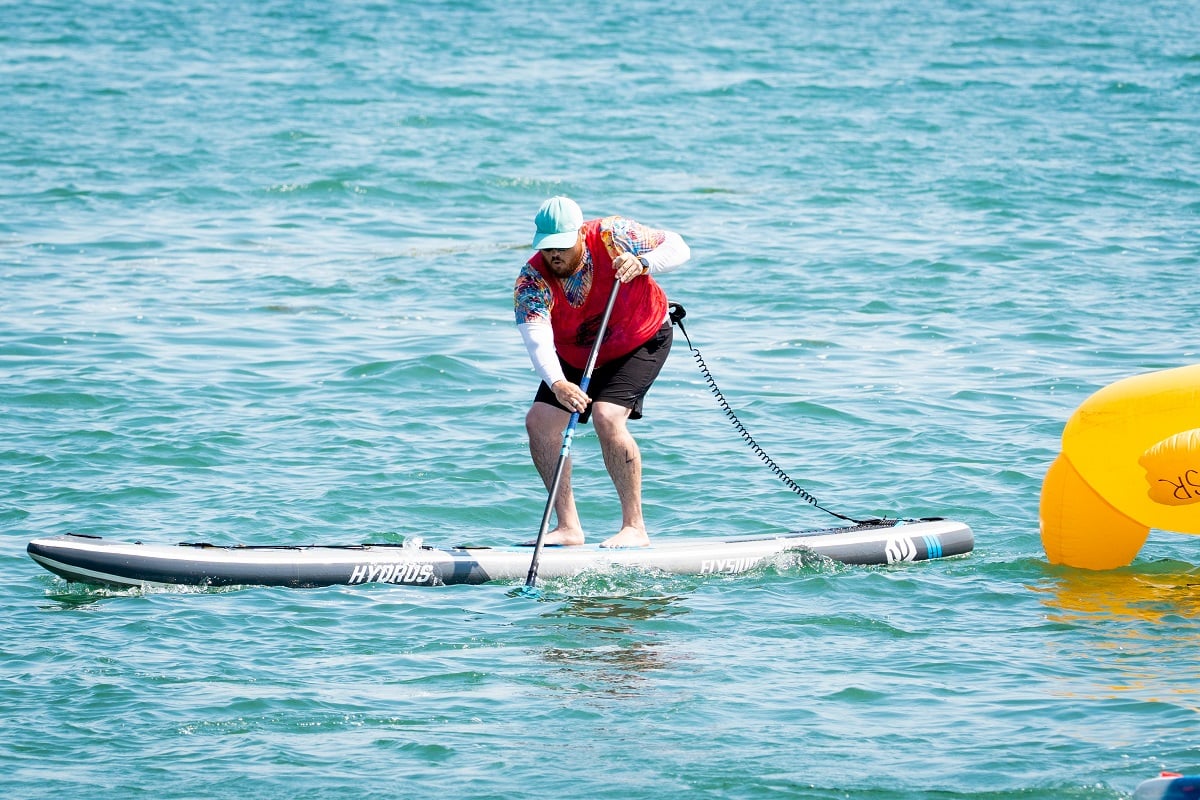
Cross-bow turning around a buoy on my weak side
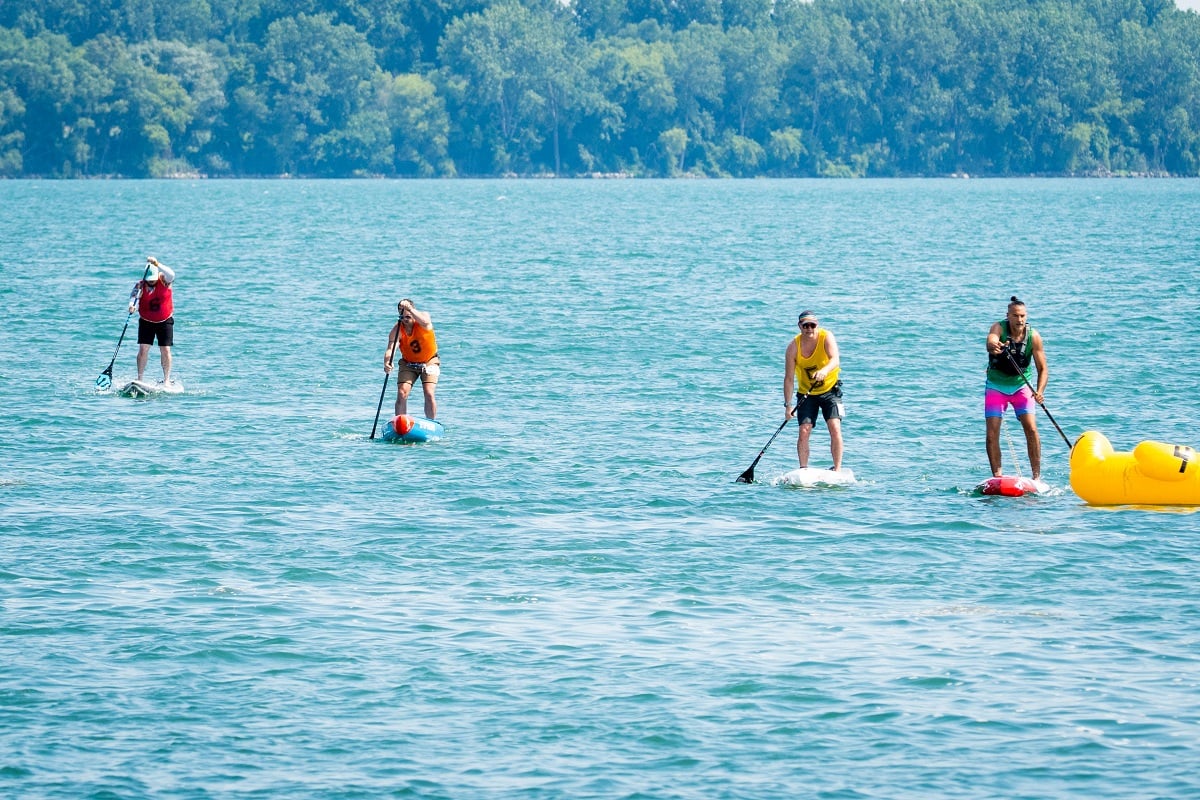
Gaining ground in the straightaway after taking a too-wide line on the first turn.
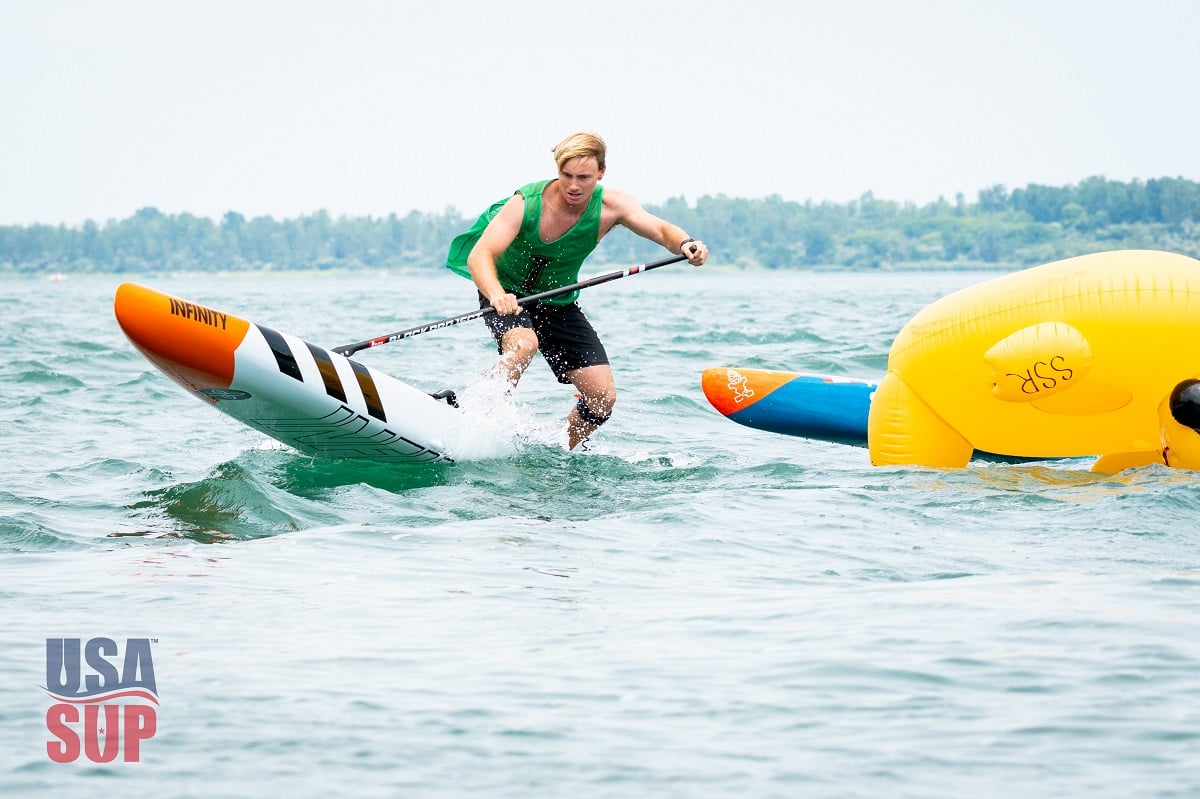
A lower perspective really shows the water and wind conditions that day.
That wind was no joke, and the raised position and telephoto compression of the photos doesn’t really show what the surface of the water was like. For the finals I got down closer to the race and onto the edge of the water and you could really get a feel for the conditions.
At the end of my heat I was in last place for my group, but my time placed me tied for 13th/17 in my division – that’s another win in my book! Watching the technical prowess of these athletes battle the conditions (and each other) made the day fly by, even though it was the longest day of the event (8am to 3pm).
Sunday July 20 – Belle Isle Classic / “10k” Distance Race
Each year USA SUP partners with an existing race to put on the National Championship in a different location around the country. This year the partner race was the Belle Isle Classic – a “10k” (closer to 7 miles) race around Belle Island state park in the middle of the Detroit River. On the north side of the island it’s a relatively quiet section of river, but the south side of the river shares an international shipping channel (large wake-producing freighters) and significant boat traffic from recreationalists as well. Did I mention that the weather wasn’t letting up?
After arriving on the Island and preparing my boards (I was also lending a second Hydrus Elysium Air to another racer this day), we had our race meeting, last minute preparations and warm ups, and the entire race began with a mass start with over 120 paddlers on the water.
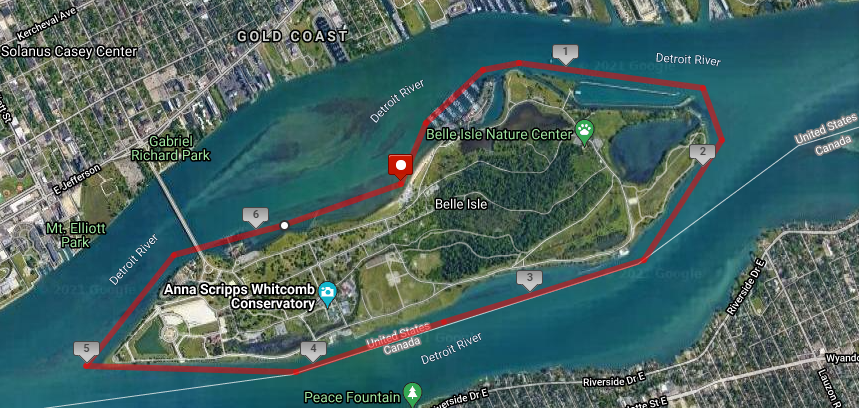
The Belle Isle Classic is a nearly 7 mile lap around Belle Isle starting upriver on the north side of the island, wrapping around and paddling downriver on the south side, and then back up river again on the north side to the finish line.
The Belle Isle classic is open to other watercraft (like outrigger canoes, kayaks, prone boards, and more) and attracts a large crowd each year. That many paddlers starting at once essentially turns the water’s surface into what feels like paddling on a roiling sea of basketballs. Chop and wash coming from every direction tips, tilts, and shifts your board around as you vie for clean water or search for the right person to draft.
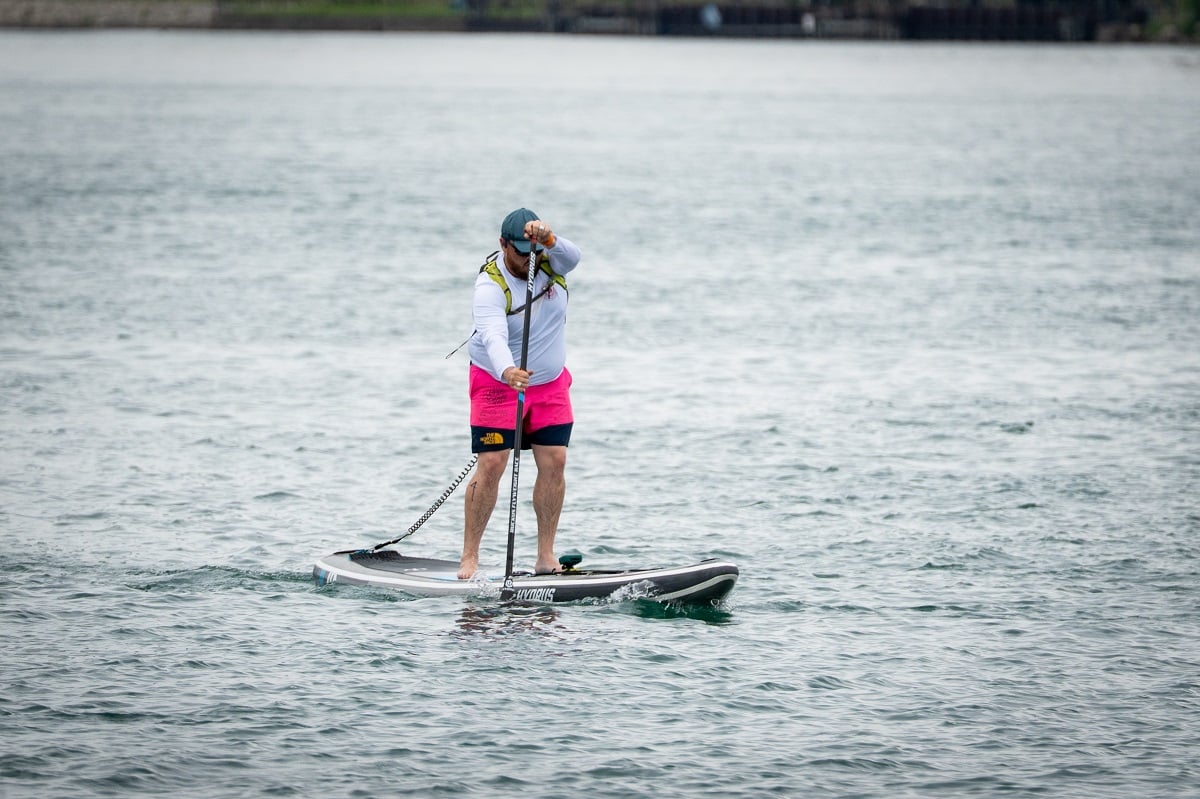
About ¼ mile into the race and focusing solely on my cadence and technique.
Over the years of paddling in these longer distance races I’ve learned (way too late) that rushing out with a sprint start if you aren’t a projected leader of the pack / top placer is generally a good way to burn up way too much energy too fast. Instead when the horn blew, I immediately focused on my target cadence of around 42 strokes per minute and tried to find a drafting partner in my speed range.
It’s typically considered a bit unsportsmanlike to simply draft off of someone else for an entire race, so once you do find someone in your speed range, it’s best to trade the draft back and forth at regular intervals so both paddlers can rest and lead. It’s not a rule, but it’s a convention that most paddlers try to follow.

Seychelle led a 10-person draft train at the front of the race for the first half mile (or more)
I found a drafting partner after about a quarter mile and tried to swap roles about every eighth of a mile after that for the first upriver leg of the race. After a few swaps I realized that they had slowed down and I needed to move on. That was right around the time we were rounding the turn and heading to the south side of the island. That’s when things got dicey for me.
I absolutely need to be practicing in harder conditions. It can be tempting to look at the weather and say “eh, it’s too windy to go out today,” or “I’m gonna stick to this protected area,” but then you don’t get the experience of paddling in those conditions.
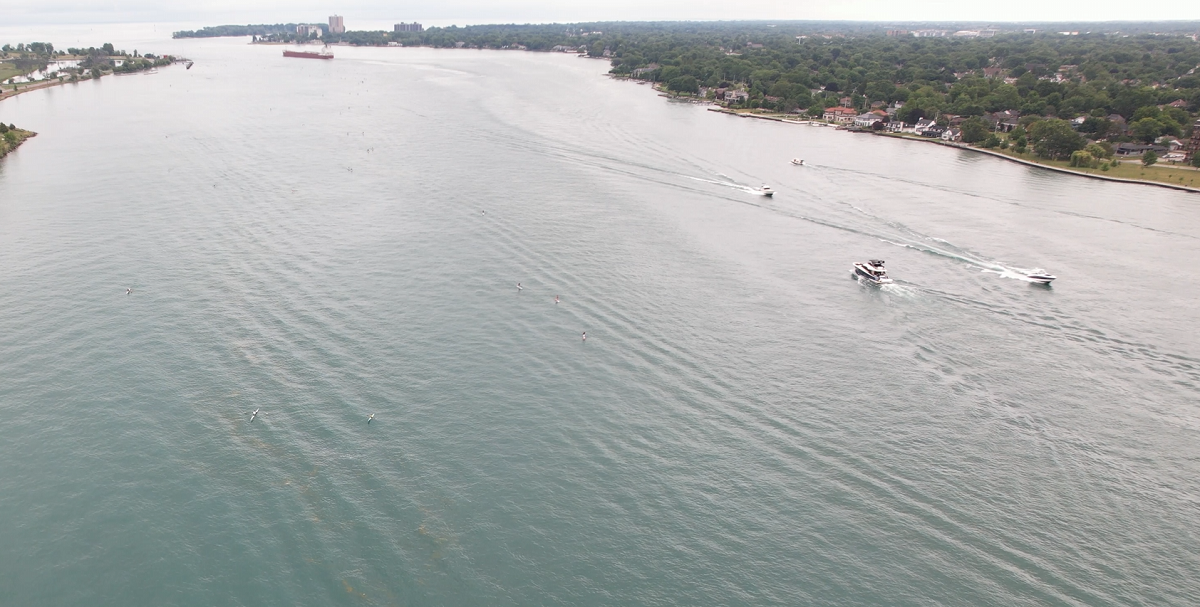
A freighter passing the bulk of the race in the background with multiple large pleasurecraft driving near the head of pack (open in new tab to enlarge)
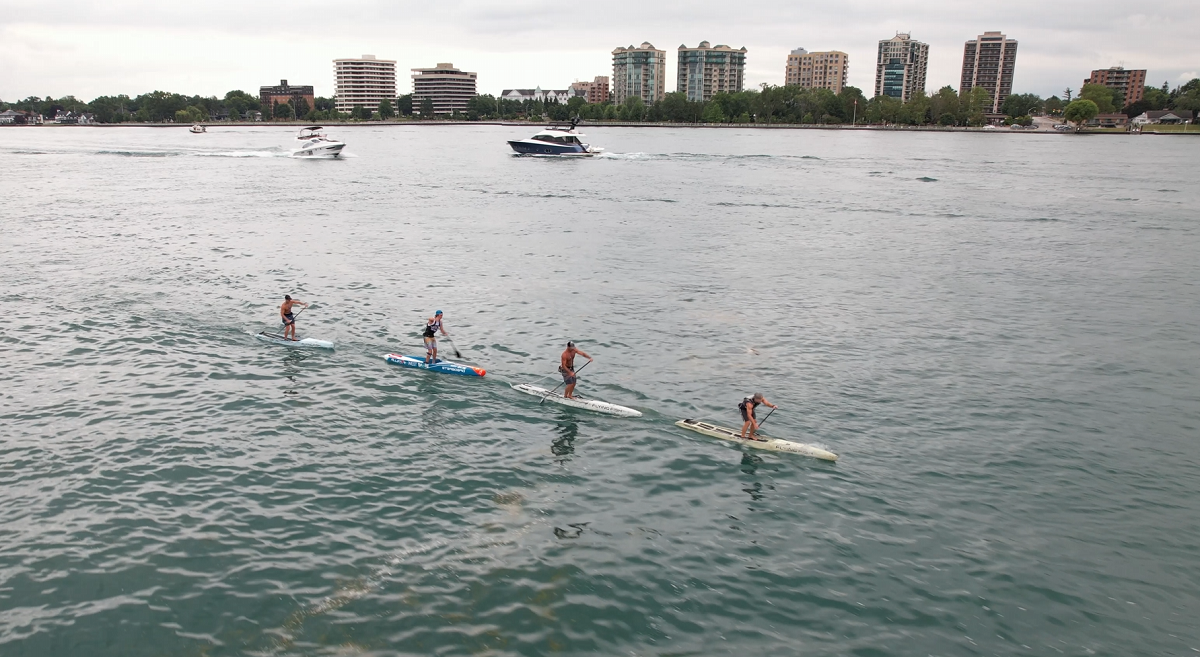
Men’s Open division race leaders in a draft train.
The south side of the island had some pretty intense boat wake from both freighters and large recreational boats. Definitely larger than any I’ve paddled through before. And, since this is a river, the race line runs through the deeper, faster section of the water where that traffic is concentrated. So this is where you paddle to try and help make up for time and speed you lost paddling upriver on the other side.
I definitely had to drop down and take a knee through some of the wake. It was brutal. The paddlers around me were all in the same metaphorical boat. Trying to fight that size wake coming in from the side was causing my calves and feet to cramp, my back to cramp, and gave my quads a mean case of “Elvis Leg.” Usually you can just turn into the wake (or with it) to more easily ride it out, but with the consistency and direction that would mean turning 90° off course every few minutes. As the water would calm down I would hop back up and get revved up as much as possible, regularly hitting 8 MPH with the current under me. That was barely enough to make up for the 3.5 MPH I was averaging against the current on the first upriver leg.
A few times I did notice that part of this was from the higher standing position of the 6” thick inflatable race board vs a dugout carbon fiber race board. However, that can also vary depending on the shape of the hull. Hard boards with more rounded hulls or deep V-hull shapes will feel very rolly or tippy in any side chop even with a dugout standing deck.
With the end of the island in sight (and thankfully calm waters, too) I rounded the turn with 2 miles left in the race. I refocused on my cadence and technique, and started targeting paddlers in front of me to pass.
There’s no better feeling than passing an outrigger canoe while paddling a SUP 😁 But it was a hard-won pass. Of course nothing could be totally smooth sailing on this course, so after a brief respite from the boat wake on the other side of the island, a lovely 15kt wind kicked up from the north east – aka a ¾ headwind for the rest of the race. Oh boy. While it feels amazing to pass an outrigger canoe, it feels equally sad to realize that your steady pace and power that got you that positioning is only moving you at 2.8 MPH against the elements.
But thankfully the wind subsided (a little bit) after ten or fifteen minutes and I was making time again.
With the finish line chute in view just a half mile away I picked up the pace and focused on giving it everything I had and finishing strong. The race didn’t end on the water, you had to run up through the chute all the way to the timing booth to officially finish.
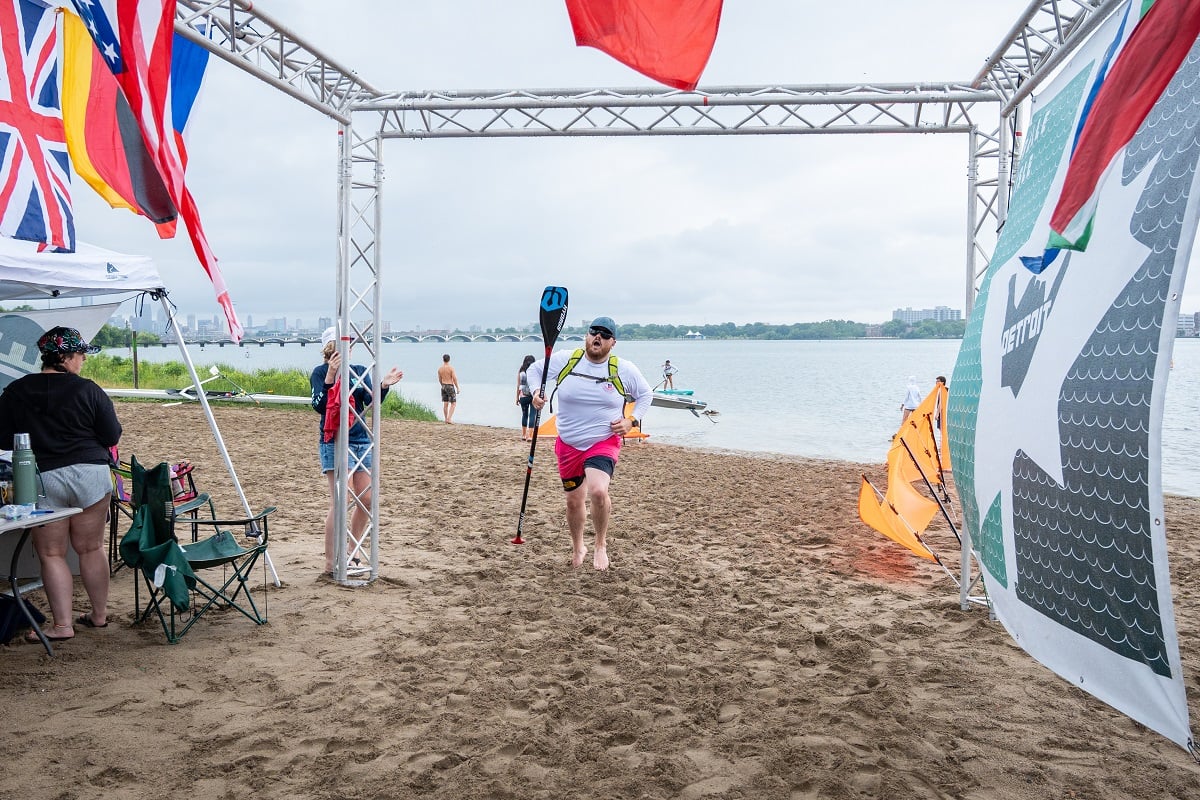
And it was a running beach finish to the flags!
I crossed the finish line in 1 hour, 38 minutes for a 6.7 mile course. That’s about fifteen minutes slower than I was shooting for, but considering the conditions I was still very happy with my result – 13th/20 of the USA SUP Men’s Open division racers and fastest inflatable on the course (there were a few others this time around).
Final Thoughts
What an incredibly fun event! I am so happy that I was able to get to Detroit for these races, have fun on the water, and meet a bunch of awesome people.
Ian, Evan, Troy, Clint, and Brian – the usual suspects I was up against – y’all killed it. I can’t wait to race you again next year! Jake – slow down a bit for the rest of us, eh?

USA SUP President Linda McCoy and I at the finish line of the 10k Belle Isle Classic race.
Big shout out to Linda McCoy – USA SUP President, Harrison Withers – USA SUP National Championship Race Director, Daniel Novak – Belle Isle Classic Race Director, Nico Sparks – Drone operator, Sharayah Williams – photographer, and all of the other dozens of volunteers for making this such an awesome event. Another big shout out to all of the sponsors, including top-level sponsor Hydrus Board Tech for their support of USA SUP.
USA SUP has a recap webpage with the results list, hundreds of photos of the races, and links to all of the sponsors. Check out USASUP.org to see all the action.
If you aren’t a USA SUP Member, you should join! Members get access to members-only sections of the USA SUP website and communities, discounts with participating partner brands, discounts on certain races, inclusion in race rankings for the USA SUP Regional Race Series and National Championships, and more.
This year Hydrus is giving away a complete racing package – Hydrus Elysium Air SUP, Ruckus Race Paddle, and Katana 2.0 or Riptide 2.0 fin – to one random USA SUP member at the end of the year – but you have to sign up before December 12th to be eligible!
Whether or not you are a highly competitive individual, SUP races are an absolute blast. Everyone is out on the water having a good time, and they are a great community bonding event as well. I highly recommend looking up a race in your area on the USA SUP Calendar (they are color coded by region), and get out there and have some fun!
Equipment I Used
As I mentioned at the top of the post, I was, until the 10K race, the only paddler on an inflatable SUP. I used to race on a carbon fiber NSP Ninja (14’ x 25”) but last year, after lots of testing and racing, have switched full time to racing on the Hydrus Elysium Air (14’ x 26”). I’ve found that I’m personally just as fast on the Elysium as I was on the Ninja. Not only that, but I can easily take the board with me when I travel for races. No fuss about finding a board to borrow and whether it will be the size or shape I’m used to!
Hydrus has always been about Performance First design, and it shows. But they also have a mission – get people out on the water! Hydrus owner Jason Zawadzki told me that while in development of their racing series he was shocked and appalled at what some companies were charging for things like paddles and fins. Knowing exactly what goes into the production process for these items, he knew that Hydrus could offer a line of affordable racing gear that meets or exceeds those same levels of performance and quality as the more expensive brands.
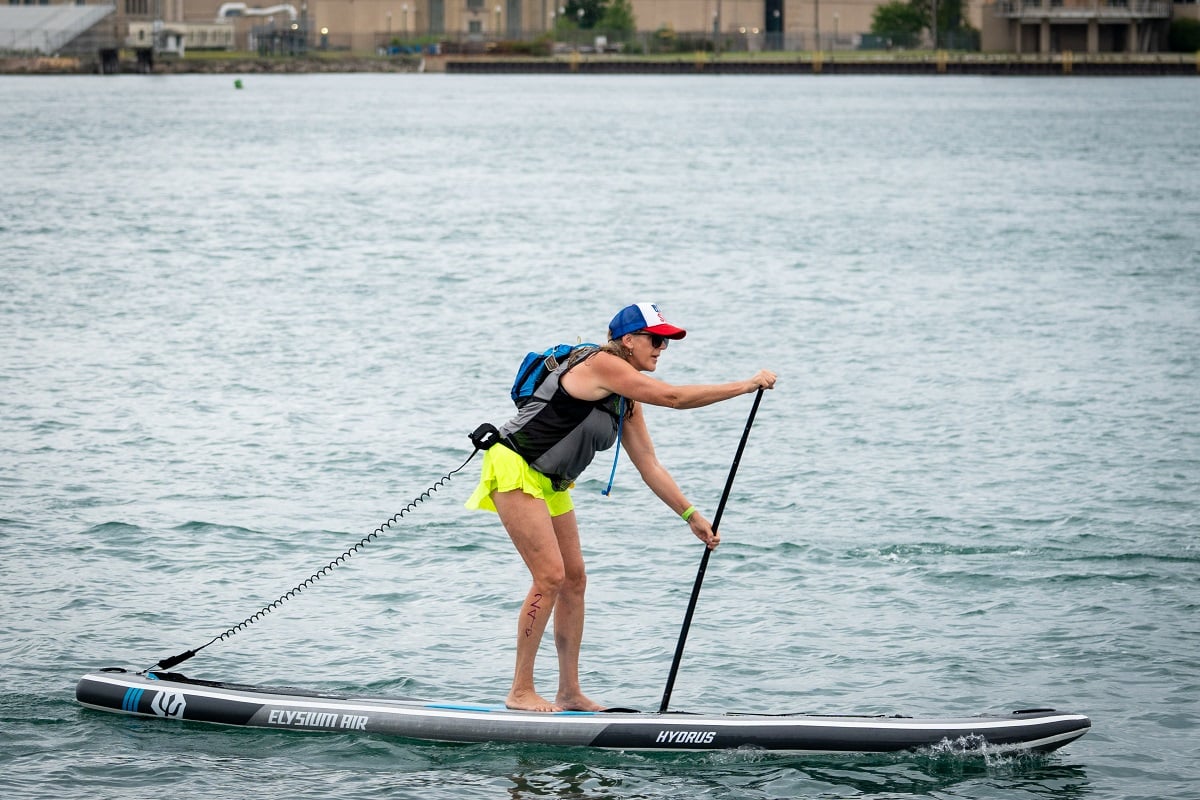
USA SUP President Linda McCoy paddling a Hydrus Elysium Air during the Distance Race. The Hydrus Elysium Air is 14’ x 26” x 6”, 25.6 lbs, and ridiculously fast.
Racing inflatables have come a very long way over the last few years in both design and construction. I personally feel that these are the future for expanding SUP racing as a sport. While elite paddlers like Seychelle and Jake are able to use ultra-narrow carbon boards to their fullest potential, the reality of it for the rest of us is we are usually on boards 23-26” wide to begin with and we as the board’s “motor” are the slowest part of the equation. Not to mention that inflatable race boards are far easier to care for, transport, source, and are about one third the cost of a carbon fiber board. The Elysium Air is currently available for $935 with code “BOARDER.”
Paddles can make as much of a difference in your speeds as your board. I’ve tested dozens of paddles from inexpensive aluminum to $600 ultralight racing paddles.
For the Sprint and Technical races I used a Hydrus Tough Blade 1-piece paddle. It has a low flex carbon fiber paddle shaft, a large ~94 square inch blade, and weighs just 20.15 ounces (cut to 74”). It’s got a great amount of power for these shorter races and is light enough with a rectangular shaped blade for high-cadence paddling.
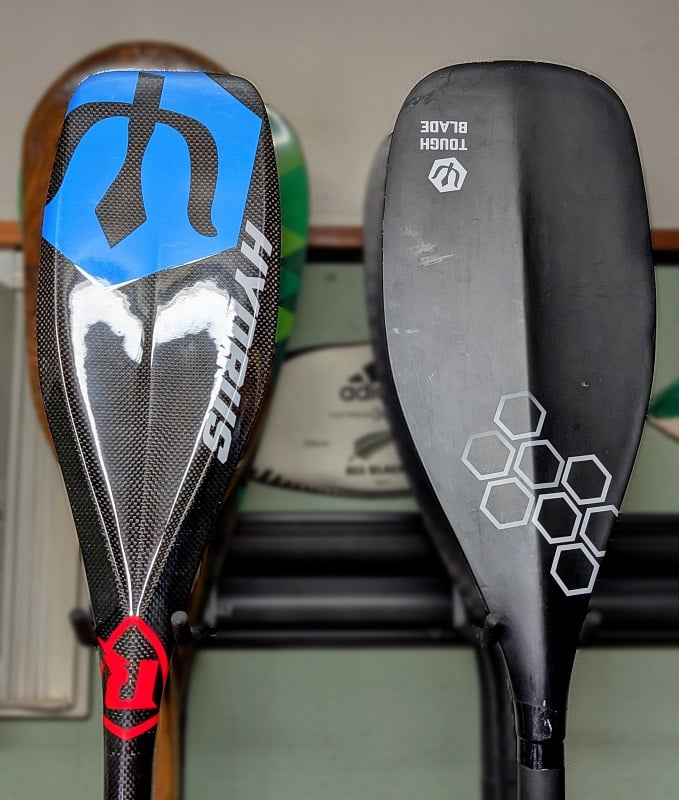
Hydrus Ruckus Flyweight blade (left) and Tough Blade blade (right).
For the Distance race Hydrus sent me a pre-production Ruckus Flyweight Race Paddle to use. This new paddle is designed for the highest level of performance. It has a lightweight and stiff carbon fiber shaft, a composite handle designed to reduce fatigue, and a new 30T prepreg carbon fiber blade with a double concave and toe scoop that gives an effortless and instant catch, but releases cleanly at the end of the stroke. This first version of the Ruckus has a smaller blade meant for distance paddling and very high cadence paddling with a width just under 6.5” and a surface area estimate of around 86.5 square inches. I’ve compared this to my Quick Blade UV 88 and prefer the Ruckus whole-heartedly.
The Ruckus Flyweight is on pre-sale right now for an insanely low price of $235 (including a bag) before the 12% discount with code “Boarder”, but once the paddles arrive, the price is going to go up! The Hydrus Tough Blade 1-piece paddle is available for under $200 with discount.
Lastly I used Hydrus’s new Katana 2.0 and Riptide 30T prepreg carbon fiber race fins under the Elysium depending on the race.
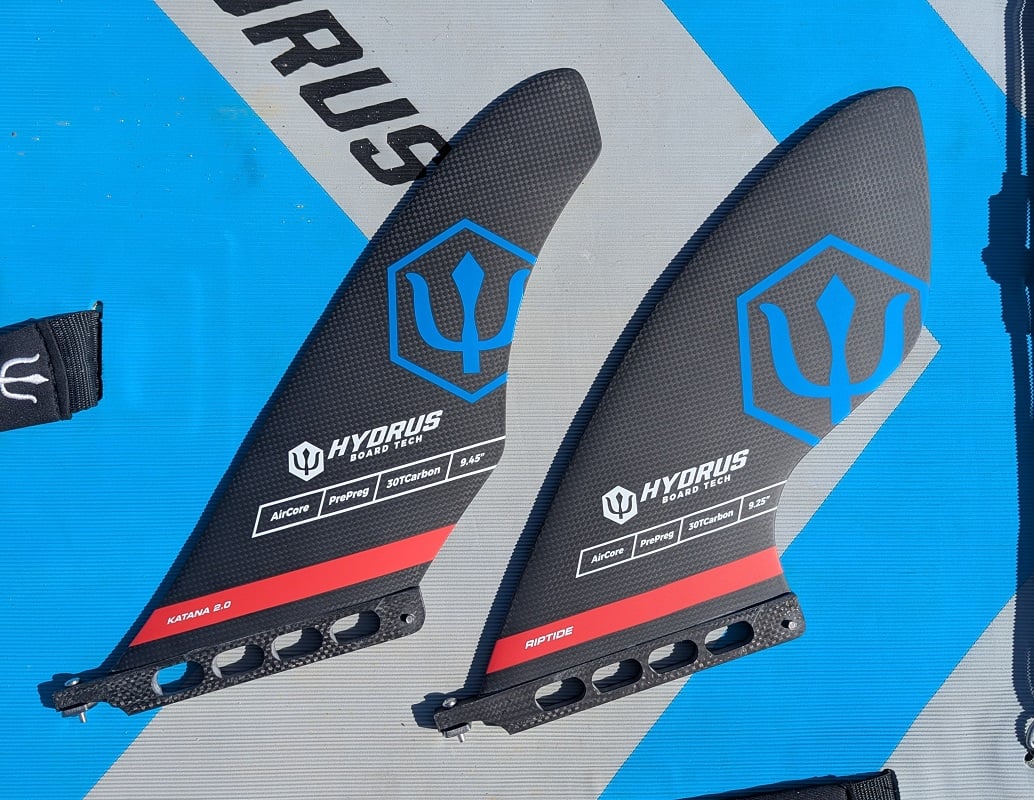
Hydrus Katana 2.0 (left) and Riptide (right) fins.
I used the Riptide during the Sprint and Distance races. In both of these races I wanted to maximize my tracking – the straighter the line I could paddle the faster I will go. The swept back shape also makes it great for handling weeds – of which there were a lot in the Detroit River. The times I couldn’t avoid paddling into a clump of floating weeds I could feel the board lurch as they hit the fin, but they always slid off easily a second later.
I used the Katana 2.0 fin for the technical race. The narrower shape and more vertical rake angle provide for less drag and more maneuverability, but don’t track quite as well as the larger surface area of the Riptide. But that’s perfect for short courses with lots of tight turns!
Both the Katana 2.0 and Riptide fins are currently on presale (while new stock arrives) for $79 before the 12% discount with code “BOARDER.”
Adding it up, that puts a complete racing kit of high-quality equipment delivered to your doorstep for under $1300 – that’s less than half the cost of the least expensive hard racing SUPs (without shipping or accessories)!
A few other odds and ends I used during the races:
- Inflatable Belt Pack PFD PFDs were required for every race
- Osprey Katari hydration pack for the distance race
- Shokz OpenRun Pro 2 headphones for the distance race




Leave a Reply